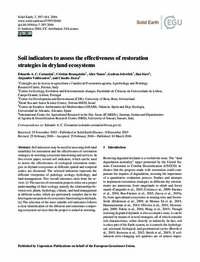Soil indicators to assess the effectiveness of restoration strategies in dryland ecosystems

Authors:
Soil indicators may be used for assessing both land
suitability for restoration and the effectiveness of restoration
strategies in restoring ecosystem functioning and services. In
this review paper, several soil indicators, which can be used
to assess the effectiveness of ecological restoration strategies
in dryland ecosystems at different spatial and temporal
scales, are discussed. The selected indicators represent the
different viewpoints of pedology, ecology, hydrology, and
land management. Two overall outcomes stem from the review.
(i) The success of restoration projects relies on a proper
understanding of their ecology, namely the relationships between
soil, plants, hydrology, climate, and land management
at different scales, which are particularly complex due to the
heterogeneous pattern of ecosystems functioning in drylands.
(ii) The selection of the most suitable soil indicators follows
a clear identification of the different and sometimes competing
ecosystem services that the project is aimed at restoring.
